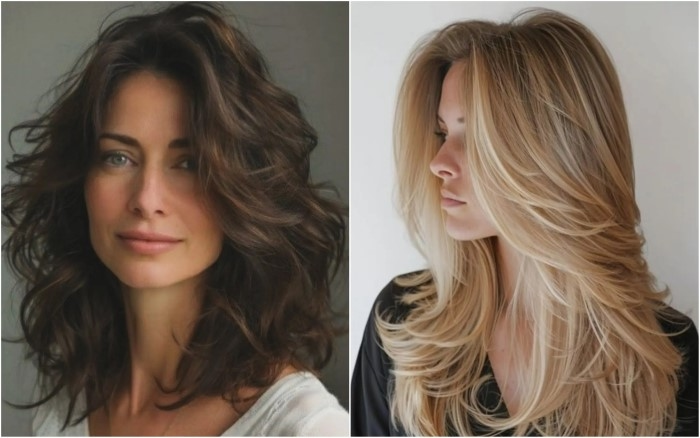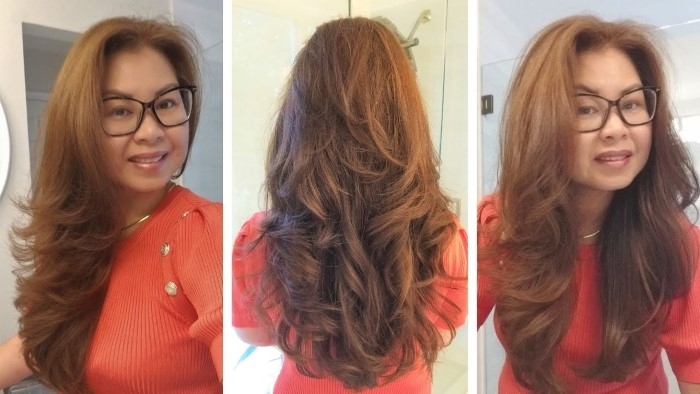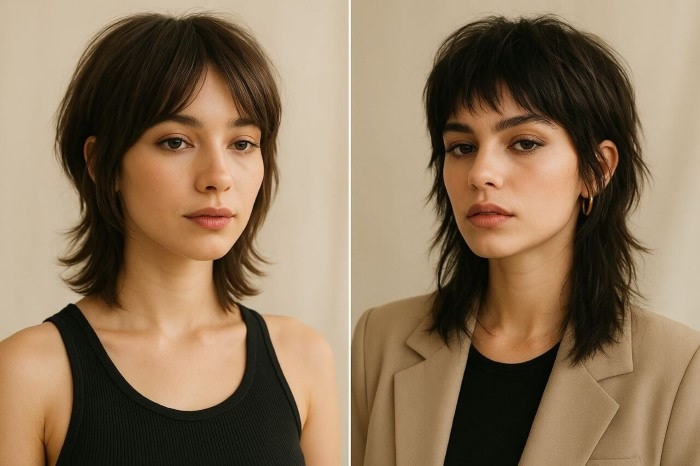You want movement without chaos. Volume without losing your ponytail. A look that feels like you on a good day. That’s the promise of a butterfly cut. Light, face-framing wings. Gentle lift at the crown. A perimeter that stays long enough for clips, braids, and busy mornings. In this guide, we’ll cover what a butterfly cut is, who it suits, how to ask for it, how to style it fast, and how to keep it pretty between trims. By the end, you’ll know exactly how to make a butterfly cut work in real life.
What Is a Butterfly Cut?
A butterfly cut is a layered design with intention. Shorter pieces around the face arc outward like wings. Longer layers glide down the back and shoulders. The crown gets rounded elevation for height without teasing. Ends stay substantial, not wispy. Movement is built into the architecture, so hair looks lively even when you do very little.
Key Features
- Rounded crown layers that add lift
- Face-framing pieces that open the eyes and carve cheekbones
- Internal shaping to reduce bulk while protecting the last inch of length
- A clean perimeter you can still tie back
Why It Flatters
The eye reads a gentle vertical through the crown and a soft diagonal near the cheeks. That pairing lengthens, slims, and brightens. A butterfly cut is smoother than a shag, gentler than a wolf cut, and more dynamic than classic long layers. It organizes your texture instead of fighting it.
Who a Butterfly Cut Suits: Face-Shape Tuning

Round Face
Ask for a touch more lift up top and wings that begin just below the cheekbone. This version of a butterfly cut elongates the face and sends the eye down and out. A soft off-center part can be especially kind.
Oval Face
You can play. Brow-grazing face frame for sweetness. Cheekbone wings for drama. Balance is built in, so choose the mood you want to carry.
Square Face
Feather the frame so it curves inward at the jaw before flicking out. That gentle C-then-S motion softens strong angles without losing strength. A butterfly cut keeps definition, not severity.
Heart Face
Use a slightly fuller face frame to balance a wider forehead. Let the wings land at or below the jaw. The effect redistributes width exactly where you want it.
Long or Rectangular Face
Go easy on crown height. Keep the face frame slightly shorter and wider to visually shorten the canvas. A butterfly cut becomes calm, flattering, and easy to wear.
Hair Type and Density: Make It Yours
Fine or Low Density
Protect the last inch. Ask for minimal end-thinning and rounded crown layers. Choose airy mousse over heavy oil. A butterfly cut creates lift without see-through tips when ends stay healthy.
Thick or High Density
Request internal debulking and slightly longer wings. You’ll keep swing without bulk. Finish with a flexible cream instead of heavy serums so the shape stays buoyant.
Straight Hair
Expect crisp wings and glossy lines. A medium round brush or two large Velcro rollers will set the flip in minutes. A butterfly cut on straight hair reads clean, modern, and precise.
Wavy Hair
Waves fall into S-curves that echo the wings. Scrunch a lightweight cream. Diffuse or use a quick heatless front set. A butterfly cut often looks “done” before you try.
Curly or Coily Hair
Yes—with intention. Shape curl-by-curl near the face. Keep the perimeter even. Longer front pieces let coils spring outward for that winged effect. A butterfly cut on curls feels sculptural and romantic.
How to Ask Your Stylist (Words That Land)
Bring two or three photos that match your texture and part. Then say:
- “I want a butterfly cut at (collarbone / mid-back) length.”
- “Rounded crown layers for lift, and face-framing wings that flip away from my face.”
- “Please protect the last inch—no aggressive thinning—and keep the perimeter ponytail-friendly.”
- “Remove bulk internally where my hair stacks.”
- “I mostly style (heatless / quick blowout / diffuser). Please cut forthat.”
Ask for a dry check at your real part. Wings should land at the cheek or lip when your hair is living its normal life.
Bring Visual Clarity
- One photo for wing length
- One for overall density and ends
- One for fringe or no-fringe preference
Common Consultation Mix-ups
- “Layers everywhere” turning into choppy ends. Specify: soft, rounded layers, not aggressive texturizing at the perimeter.
- “Volume” is becoming too high. Say: subtle lift, not a dome.
- “Face-framing” cut too short. Start at cheek or lip; refine later.
Styling a Butterfly Cut: Three Fast Routes

Quick Blowout (6–8 minutes)
- Start damp. Heat protectant everywhere; root-lifting foam at the crown.
- Rough-dry to 80 percent with your head flipped forward.
- With a medium round brush, over-direct the front sections and roll them away from the face to set the wings.
- Blow-dry the face frame forward first, split it, then sweep each side back for a soft curtain.
- Set two or three Velcro rollers at the crown while you get ready.
- Release, finger-comb, pinch ends with a pea of cream, mist a flexible spray.
A butterfly cut loves this rhythm: light, quick, repeatable.
Heatless Wing Set (Passive time, zero stress)
- Lightly dampen the front and crown.
- Wrap the two front sections away from your face with large Velcro rollers; add one at the crown.
- Make coffee, answer messages.
- Remove, shake, define ends.
Your wings pop back like muscle memory.
Curly/Coily Flow (Defined yet soft)
- Heat protectant—yes, even with a diffuser.
- Foam at roots; curl cream or gel through mids and ends.
- Diffuse on low to 80–90 percent dry.
- If you want extra face-framing definition, give the front two pieces a brief tension stretch, then let them spring.
- Scrunch out any cast for touchable bounce.
Daily Habits That Keep Lift and Shine
- Always use heat protectant—even on diffuser days
- Favor foams and flexible sprays over heavy serums
- Park one front roller while you brush your teeth
- Sleep on silk or in a loose top bun to protect the flip
- Clarify weekly if dry shampoo is a habit, then mask to restore elasticity
These tiny rituals are the difference between flat and float in a butterfly cut.
Care and Maintenance
Plan trims every eight to ten weeks. Shorter face pieces or a fringe may want a four- to six-week tidy-up. Because the layers are rounded and blended, a butterfly cut slides from “fresh” to “flirty” rather than collapsing. Stretching appointments? Ask for micro-trims that dust the ends and refresh the wings without shortening the perimeter.
Seasonal Adjustments
- Humid months: layer foam, then a whisper of gel on the outer canopy; scrunch out the cast later.
- Dry months: a single drop of lightweight oil on wet tips only; seal before styling.
- Windy days: braid the back loosely, leave the face pieces free. Release later—instant wings.
Color Pairings That Love the Wings
- Face-framing highlights 1–2 levels brighter to spotlight the flip
- Balayage ribbons through mid-lengths for depth without harsh lines
- A clear or tinted gloss for camera-friendly shine
Color is optional; shine is essential. Light needs a path. A butterfly cut gives it one.
Mistakes to Avoid (and Kind Fixes)
- Wings cut too short: start at cheek or lip; refine next visit.
- Over-thinned ends on fine hair: protect the last inch; let foam create lift instead.
- Heavy oils everywhere: micro-dose on tips only—or skip. Weight kills movement.
- Skipping heat protection: shine fades, frizz rises.
- Ignoring your part: have the shape checked dry at the part you actually wear.
A thoughtful butterfly cut avoids extremes. Balance beats drama.
How a Butterfly Cut Compares

- Shag: Choppier and piecey. Lived-in grit, less gloss.
- Wolf Cut: Short crown, long perimeter, high contrast. Edgier.
- Classic Long Layers: Subtle movement, less face-framing intent.
- Butterfly: Smoother surface, winged motion, lift with minimal effort.
If you want flow and polish, choose the butterfly. If you want rock-and-roll, choose shag or wolf.
Personalize Your Version
- Cheekbone wings for sculpted drama
- Lip-skimming wings for romance
- Micro curtain fringe that tucks easily for work
- Soft side part on days you want kindness
- Collarbones for bounce, mid-back for drama, waist for maximum swish
A butterfly cut should feel like you—only lighter.
A Five-Day Refresh Plan
- Day 1: Full routine—blowout or heatless set; crown roller while you get ready.
- Day 2: Dry shampoo at roots; one front roller refresh during coffee.
- Day 3: Water mist, cream scrunch, ten-minute crown clip.
- Day 4: Brush-out; curl only the two face pieces away from your face for five seconds, then brush smooth.
- Day 5: Low braid or claw clip; pull a few face pieces loose. The wings keep the line soft.
This cadence respects your calendar, not just your mirror.
Mindset: Beauty That Feels Like Relief
Hair is a mood you can touch. A butterfly cut gives you lift where you need it and length where you love it. It says, “You can be polished without performing.” On hard mornings, that’s mercy. On good ones, it’s momentum.
FAQs
What makes a butterfly cut different from regular long layers?
Placement and purpose. The crown elevation and outward-sweeping face frame are designed to open the face and create bounce with minimal effort.
Will a butterfly cut work on fine hair?
Yes—if ends are protected. Keep the last inch substantial, limit thinning, and rely on airy mousse and rollers for lift.
Can I style a butterfly cut without heat most days?
Absolutely. Two large front rollers and a crown clip revive wings while you get ready. Air and time do the rest.
How often should I trim the wings or front pieces?
Every four to six weeks for the front, eight to ten for the overall shape. Small dustings keep the flip lively.
Is a butterfly cut office-friendly?
Very. It reads polished with a quick brush-out and soft with natural texture. Easy to tuck, clip, or tie back for work.
Choose ease on purpose. A butterfly cut is flow and clarity in one shape—light wings, gentle lift, and a long perimeter that still does everything you need. Bring photos. Speak your routine. Ask for dry checks and protected ends. Then step out knowing your hair will meet the day with you—calm, bright, and ready.

